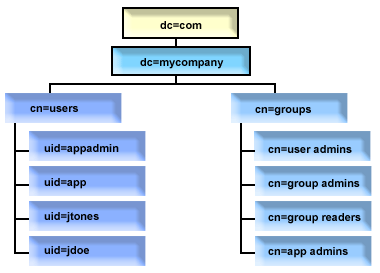
Recommended practices for directory structure
The Directory Server is often used as a repository for users and groups.
This section describes some recommended practices for setting up a structure
that is optimized for managing users and groups. This structure and associated
security model can be extended to other uses of the directory.
Users are typically stored in a single, or few, locations. You might have
a single container, cn=users, that is the parent entry for all users, or separate
containers for distinct sets of users that are administered separately. For
example, employees, vendors, and self-registered Internet users might be located
under objects named cn=employees, cn=vendors, and cn=internet users, respectively.
One might be tempted to place people under the organizations they belong to;
however, this can create difficulties when they move to another organization
as the directory entry then also needs to be moved and groups or other data
sources (both internal and external to the directory) might have to be updated
to reflect the new DN. The relationship of users to the organizational structure
can be captured within the user entry using directory attributes such as "o"
(organization name), "ou" (organizational unit name), and departmentNumber
which are part of the standard schema for organizationalPerson and inetOrgPerson.
Similarly, groups are typically placed in a separate container, for example
a container named "cn=groups".
By organizing users and groups in this manner, there are only a few places
where access control lists (ACLs) need to be set.
Depending on how the directory server is used, and how users and groups
are managed, you might use one of the following access control patterns:
- If the directory is used for applications like an address book, you might
want to grant the special group cn=anybody read and search permissions for
"normal" attributes in the cn=users container and its parent objects.
- Often, only the DNs used by specific applications and group administrators
need access to the cn=groups container. You might want to create a group holding
the DNs of group administrators and make that group the owner of cn=groups
and its subordinates. You might create another group holding the DNs used
by applications to read group information, and grant that group read and search
permissions to cn=groups.
- If user objects are updated directly by users, you will want to grant
the special access-id cn=this appropriate read, write, and search permissions.
- If users are updated through applications, often those applications run
under their own identity, and only those applications need authority to update
user objects. Once again, it is convenient to add these DNs to a group, for
example, cn=user administrators, and grant that group necessary permissions
to cn=users.
Applying this type of structure and access control, your initial directory
might look like this:
Figure 3. Example directory structure
- c=mycompany, dc=com is owned by the directory administrator, or another
user or group with authority to manage the top level of the directory. Additional
ACL entries grant read access to normal attributes for one of cn=anybody or
cn=authenticated, or possibly some other group if a more restrictive ACL is
needed.
- cn=users has ACL entries beyond those described below to allow appropriate
access to users. ACLs might include:
- read and search access to normal attributes for cn=anybody or cn=authenticated
- read and search access to normal and sensitive attributes for managers
- other ACL entries as desired, perhaps allowing write access for individuals
to their own entry.
Note:
- To improve readability, RDNs of entries have been used rather than the
full DNs. For example, the "user admins" group would have the full DN uid=app,cn=users,dc=mycompany,dc=com
as a member rather than the shorter uid=app.
- Some users and groups could be combined. For example, if the application
administrator was to have authority to manage users, the application could
run under the application administrator DN. However, that might restrict the
ability, for example, to change the application's administrator password without
also reconfiguring the new password in the application.
- While the above represent best practices for directories used by only
one application, it might be more expedient to have all updates done authenticating
as the directory administrator. This practice is discouraged for reasons discussed
earlier.




